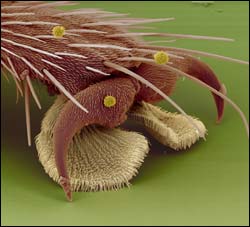Oh, what a feeling – dancing on the ceiling!

"Electron microscope image of a fly foot" (Supplied by S. Gorb)
The team led by Stanislav Gorb used optical sensors to measure the forces applied by each leg of a fly whilst walking freely on a smooth ceiling. They found that the best attachment force occurred when at least one leg from each side of the fly’s body was in contact with the surface. These principles were then proven using artificial polymer tape to simulate the adhesive pads found on the feet of insects.
“Walking on a ceiling is very different from normal walking because the gravity tends to pull an inverted insect away instead of pressing it to the surface”, explains Dr Gorb. “Our results, in combination with the knowledge on the microstructure of pads, provide important inspiration for mimicking locomotion of wall and ceiling walking machines, which use micropatterned polymer feet for generating adhesion”.
Dr Gorb will be presenting his results at the Annual Meeting of the Society for Experimental Biology on Wednesday 5th April [session A7].
Media Contact
More Information:
http://www.sebiology.org.ukAll latest news from the category: Life Sciences and Chemistry
Articles and reports from the Life Sciences and chemistry area deal with applied and basic research into modern biology, chemistry and human medicine.
Valuable information can be found on a range of life sciences fields including bacteriology, biochemistry, bionics, bioinformatics, biophysics, biotechnology, genetics, geobotany, human biology, marine biology, microbiology, molecular biology, cellular biology, zoology, bioinorganic chemistry, microchemistry and environmental chemistry.
Newest articles

A universal framework for spatial biology
SpatialData is a freely accessible tool to unify and integrate data from different omics technologies accounting for spatial information, which can provide holistic insights into health and disease. Biological processes…

How complex biological processes arise
A $20 million grant from the U.S. National Science Foundation (NSF) will support the establishment and operation of the National Synthesis Center for Emergence in the Molecular and Cellular Sciences (NCEMS) at…

Airborne single-photon lidar system achieves high-resolution 3D imaging
Compact, low-power system opens doors for photon-efficient drone and satellite-based environmental monitoring and mapping. Researchers have developed a compact and lightweight single-photon airborne lidar system that can acquire high-resolution 3D…





















